Choosing current transformers (CTs)
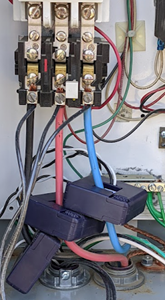 Monitoring power and energy means measuring both voltage and current at the load's source. For voltage, you tap into the wires supplying the load. For current, however, you use current transformers (CTs).
Monitoring power and energy means measuring both voltage and current at the load's source. For voltage, you tap into the wires supplying the load. For current, however, you use current transformers (CTs).
In the image at right, you see the thinner black wires for measuring voltage and the three CTs around the larger black, red, and blue wires.
 WARNING: DANGER. HAZARDOUS VOLTAGE! Direct wiring involves high voltages and must be done by a qualified electrician. See complete wiring diagrams in the groov RIO EMU Data Sheet or the groov Power Monitoring Module Data Sheet.
WARNING: DANGER. HAZARDOUS VOLTAGE! Direct wiring involves high voltages and must be done by a qualified electrician. See complete wiring diagrams in the groov RIO EMU Data Sheet or the groov Power Monitoring Module Data Sheet.
CT specs for power & energy monitoring with groov products
Here are the three specifications you need to know to choose CTs suited to the load you're measuring:
- Primary
- Inner diameter
- Secondary
Primary
The primary or current rating of the CT is specified in amps. To find out the primary you need, look at the circuit breaker or disconnect switch for the load and note the current rating of the load shown on the sticker there. Or you can check the specifications on the equipment plate or documentation. The running and peak current can be used to guide you on selecting the CT primary rating.
For example, if the sticker on your load shows 200 A, you would choose a CT with a current rating to meet or exceed that, for example, a CT rated for 250 A. A small amount of CT over-sizing is acceptable, but the larger the over-size, the lower the resolution of your measurements.
Inner diameter
The inner diameter size of the CT must be larger than the outside diameter of the load conductor in order to accommodate the wire. However, the CT opening should not be more than twice the wire diameter.
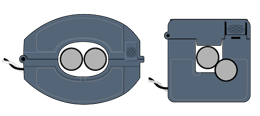 Some larger loads have more than one conductor per phase; in that case, make sure all the wires will fit into the CT. If they won’t, select either one wire or half the number of conductors, and scale the current accordingly in the groov Manage configuration section.
Some larger loads have more than one conductor per phase; in that case, make sure all the wires will fit into the CT. If they won’t, select either one wire or half the number of conductors, and scale the current accordingly in the groov Manage configuration section.
While you're checking the inner diameter required, also think about the best type of CT to fit your wires. CTs come in three basic designs.
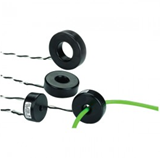 Solid-core CT. This is an older model sometimes called a “doughnut” that requires you to disconnect the load conductor to slip the CT around the cable. Solid-core CTs are more easily used for new installations; they are not desirable for existing wiring.
Solid-core CT. This is an older model sometimes called a “doughnut” that requires you to disconnect the load conductor to slip the CT around the cable. Solid-core CTs are more easily used for new installations; they are not desirable for existing wiring.
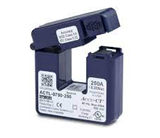 Split-core CT, also called clamp-on. This model is the best for existing installations because the CT can be opened, placed around the phase conductor, and then clamped shut. Depending on whether they are square or oval, split-core CTs can surround one or more wires.
Split-core CT, also called clamp-on. This model is the best for existing installations because the CT can be opened, placed around the phase conductor, and then clamped shut. Depending on whether they are square or oval, split-core CTs can surround one or more wires.
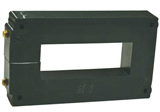 Bus bar CT. This type has a wider opening and is best for bus bars.
Bus bar CT. This type has a wider opening and is best for bus bars.
Secondary
The
secondary or
output signal of the CT is what connects to your
groov product. CT output is either current or voltage.
A secondary of 0.333 VAC is recommended, because it is lower cost, safer, and accurate from low to high currents. In addition, you can extend the CT wires if necessary (use the same gauge wire and ensure that the wires are well twisted), and you can parallel the output to other meters. Opto 22 stocks
CTs with a 0.333 VAC secondary.
Older CTs may have a current on the secondary, for example 1 A or 5 A. If you use them, be aware that CT wires should be as short as possible, long runs of CT wire can cause errors, and low accuracy can be expected at low currents. Also, they are not as safe to use. For example, a CT with a current output must NEVER be disconnected when the load is powered, and the output must not be paralleled.
Opto 22
groov energy monitoring products can support CTs with a 5 A, 1.0 VAC, or 0.333 VAC secondary.
See CTs available from Opto 22.
See Ben Orchard's blog post for more details on selecting and sizing a current transformer.